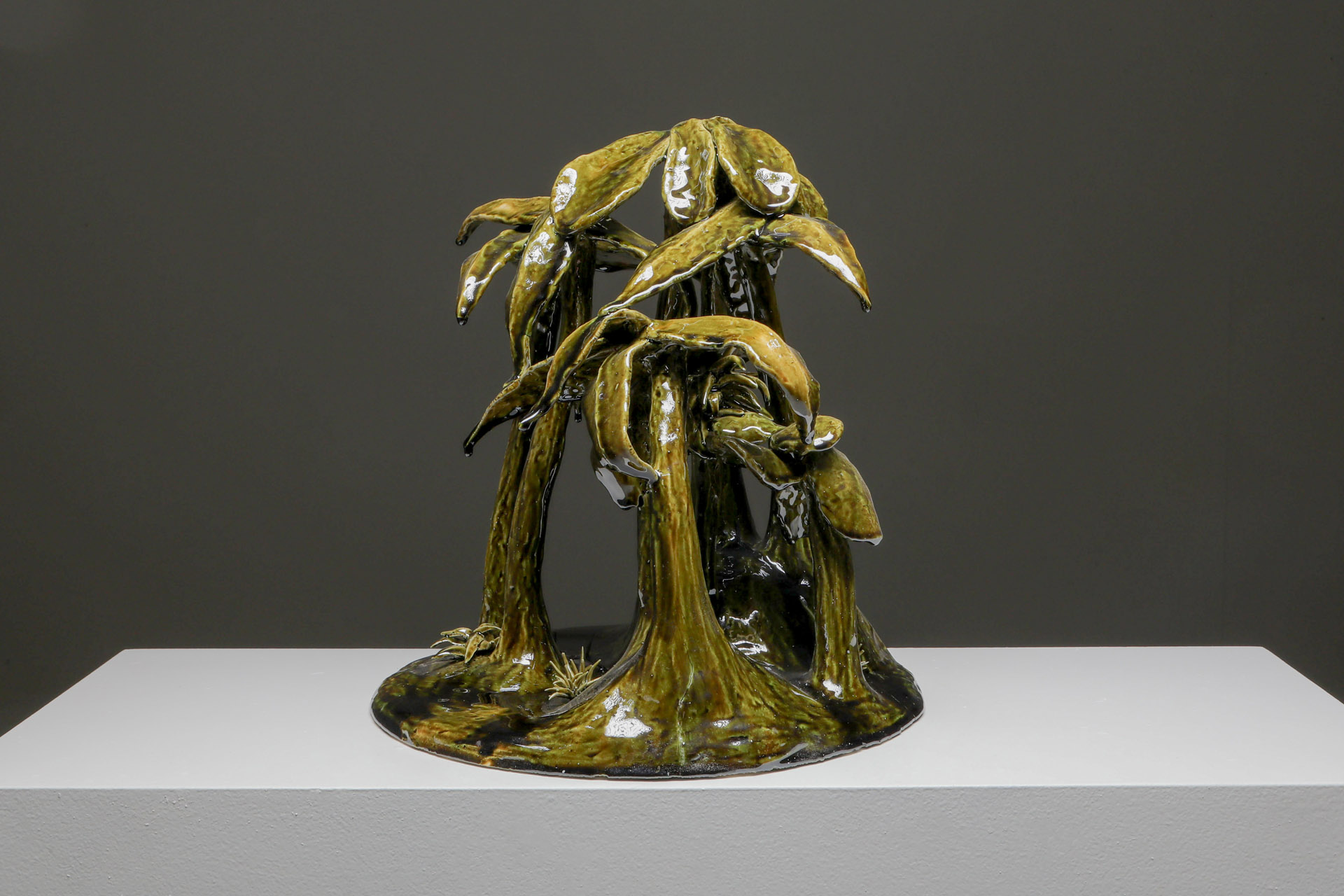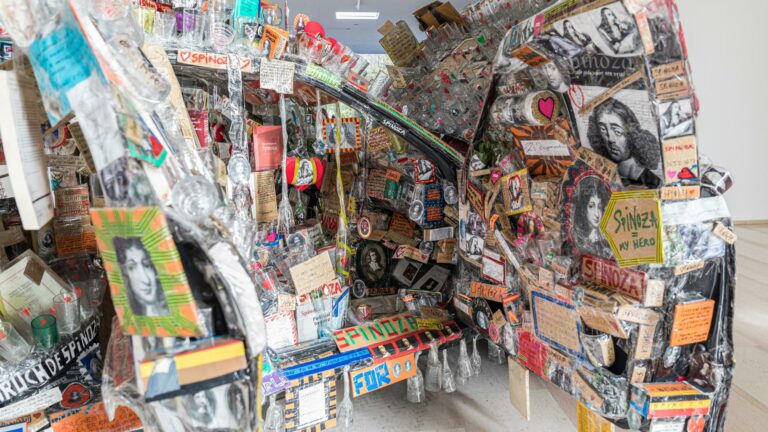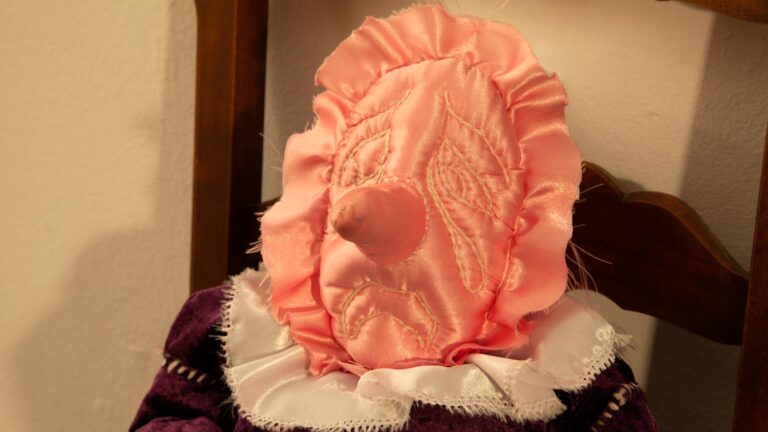Artist: Daan Gielis
Exhibition title: Omdat de wereld is zo ontrouw
Venue: Everyday Gallery, Antwerp, Belgium
Date: January 30 – March 13, 2021
Photography: Silvia Cappellari, Seppe Elewaut / all images copyright and courtesy of the artist and Everyday Gallery, Antwerp
Because of that the world is so untrue (Om dat de werelt is soe ongetru ) / This is why I grieve (daer om gha ic in den ru). So goes the caption for The Misanthrope (1568) by Pieter Breugel the Elder.
We can lash out at the world and then derail, or we can explode in rage and then implode. But is grief really a solution to being disappointed in the world? Does grief allow us to escape from that world? No, says Daan Gielis in Because the world is so untrue, his latest solo exhibition at Everyday Gallery. Those who withdraw from the world also deprive themselves of the world and thus of the possibility of being included in a larger whole that can give meaning to who we are and what we do.In Because the world is so untrue, Gielis plays a subtle political-aesthetic game that makes the visitor think about what it means to change the world without falling into either extremes of utopia or melancholy. But Gielis is not looking for a middle ground. On the contrary, he openly plays with contradiction and lets the ashes of total disappointment merrily collide with the neon of whipped-up exaltation. The mourning for the world in Breugel’s The Misanthrope forms the anchor point in this exhibition but is attacked from all sides by the energetic counterculture of hardcore. Neon as a way out of melancholy?
Or as a desperate attempt to allay the melancholy? Just like hardcore itself, Gielis’ neon works are not an unequivocal answer to injustice, disappointment or melancholy. There seems to be a way out in this subculture, a view of a different way of living together or standing in the world. But just as much they carry the risk of falling into blunt aggression – kicking just for the kick of it.
The tricky path from melancholy to a new form of engagement is therefore littered with crow’s feet in Gielis. The situation is perhaps most clearly defined by the grieving Tintin: an adventurer and benefactor always looking to to improve the world, Tintin also carries with him a racist and colonial legacy. Any real engagement with the world, Gielis seems to suggest, must pave its way through the realization that it is precisely this engagement that was often corrupt or accompanied by senseless violence. Melancholy and infidelity are always lurking, but they are no alternatives, because despite everything there is a world to be won.
Two artists. Two exhibitions. Two formal languages. Tom Volkaert’s sculptures are made from epoxy and steel and it is their size that makes them impressive. Gielis’ bronze and ceramic figurines, on the other hand, are intriguing precisely because of their introverted smallness. Gielis’ sharply defined neon sculptures are almost repulsive due to their appealing colors. Volkaert’s amorphous shapes and steel cut-outs are appealing because of their repulsive color schemes.
And yet: in spite of the apparent difference between the formal language of Gielis and Volkaert, these artists share an attitude; or even what one might call a counter-language.
What might a counter-language be? The visual language that Gielis and Volkaert have each developed in their own way often refers to an underground culture that escapes the mainstream of the art world. Skate and hardcore in the work of Gielis, obscure gore and old sci-fi B-movies in the work of Volkaert.
The many references to these subcultures can be understood as multitimbral voices that oppose and escape the dominant traditions of the art world. However, the real meaning and expressiveness that Gielis and Volkaert derive from these references only emerge once they are positioned within the interpretative field of the art world. It is only when interacting with a community of viewers for whom this visual language and references take on a new and artistic dimension that they truly become part of a work of art. This is the moment that meaning becomes unstable: we both recognize the underground references and are also unable to grasp them fully. As a result, these works acquire enigmatic quality.
Paradoxically, to achieve this effect Gielis and Volkaert need to let go of – and perhaps even betraying – the underground they so cherish. And at the same time, betrayal is always lurking in the art world too; after all, this world not only consists of an intimate community of viewers, but also exists (and even originated) from commerce.
In the work they created together and that brings the two exhibitions together, Gielis and Volkaert describe this paradox as «haat voor het veld (hatred for the field)». But let here be no mistake: this is also about self-hatred; about hatred for how the art world is being eaten up by the art market, and hatred for how the artists themselves are trapped in that world. The red neon letters of Haat voor de Veld (2020) somehow neutralize and obliviate the toxic, spit-green colored pool in the background – just as Gielis and Volkaert’s art pushes away the underground culture that they thrive upon, and vice versa.
Still, hate is certainly not at the core of these two exhibitions. On the contrary. Underneath the hatred we find determination and vulnerability. Volkaert’s giant snail moves as slowly as possible and carries its own world on its back, extremely vulnerable but always ready to withdraw into its own shell and wait patiently. The old man of Gielis, drags the world behind him like a heavy burden, melancholic and crutching his shoulders. Incredibly slow, the old man moves on, and so does the world in his wake. It is as if Gielis and Volkaert are saying that in spite of all the hatred, art carries this world and makes living in it bearable.
-Text by Bram Ieven
Daan Gielis, Omdat de wereld is zo ontrouw, 2021, exhibition view, Everyday Gallery, Antwerp
Daan Gielis, Omdat de wereld is zo ontrouw, 2021, exhibition view, Everyday Gallery, Antwerp
Daan Gielis, Omdat de wereld is zo ontrouw, 2021, exhibition view, Everyday Gallery, Antwerp
Daan Gielis, Omdat de wereld is zo ontrouw, 2021, exhibition view, Everyday Gallery, Antwerp
Daan Gielis, Omdat de wereld is zo ontrouw, 2021, exhibition view, Everyday Gallery, Antwerp
Daan Gielis, Omdat de wereld is zo ontrouw, 2021, exhibition view, Everyday Gallery, Antwerp
Daan Gielis, Omdat de wereld is zo ontrouw, 2021, exhibition view, Everyday Gallery, Antwerp
Daan Gielis, Omdat de wereld is zo ontrouw, 2021, exhibition view, Everyday Gallery, Antwerp
Daan Gielis, Omdat de wereld is zo ontrouw, 2021, exhibition view, Everyday Gallery, Antwerp
Daan Gielis, Omdat de wereld is zo ontrouw, 2021, exhibition view, Everyday Gallery, Antwerp
Daan Gielis, Omdat de wereld is zo ontrouw, 2021, exhibition view, Everyday Gallery, Antwerp
Daan Gielis, Omdat de wereld is zo ontrouw, 2021, exhibition view, Everyday Gallery, Antwerp
Daan Gielis, Omdat de wereld is zo ontrouw, 2021, exhibition view, Everyday Gallery, Antwerp
Daan Gielis, Omdat de wereld is zo ontrouw, 2021, exhibition view, Everyday Gallery, Antwerp
Daan Gielis, Tintin’s Jungle I, 2021, Glazed stoneware, H 36 x W 31 x D 31 cm
Daan Gielis, Tintin’s Jungle I, 2021, Glazed stoneware, H 36 x W 31 x D 31 cm
Daan Gielis, Tintin’s Jungle I, 2021, Glazed stoneware, H 36 x W 31 x D 31 cm
Daan Gielis, “We don’t really like what you do, we don’t think anyone ever will”, 2021, Glazed stoneware
Daan Gielis, Tintin’s Jungle II, 2021, Glazed stoneware, H 31 x W 31 x D 33,5 cm
Daan Gielis, Caltrop, 2020, Neon, H 119 x W 122 x D 5 cm
Daan Gielis, Agnostic front, 2020, Neon, H 112 x W 134 x D 5 cm
Daan Gielis, Guilty of everything, 2021, Terracotta, wood, iron, cement, H 67 x W 40 x D 2.5 cm
Daan Gielis, Tears of joy, 2021, Iron, fabric, H 43 x W 50 x D 17 cm
Daan Gielis, De misantroop, 2021, Bronze, silver nitrate patina, lost-wax technique, H 17 x W 23 x D 14 cm
Daan Gielis, Caltrop Stars, 2021, Iron, bronze, H 60 x W 45 x D 28 cm
Daan Gielis, Tintin’s Jungle III, 2021, Glazed stoneware, terracotta, H 38 x W 38 x D 38 cm
Daan Gielis, Subterranean Tintin, 2021, Iron, leather, wood, bronze, lead, H 160 x W 85 x D 45 cm

































